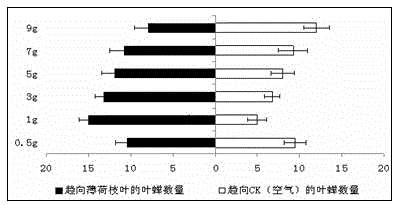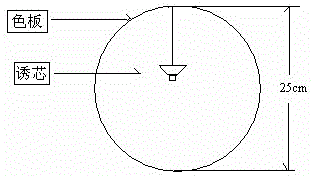A method for trapping and killing the false-eye small green leafhopper by using mint volatiles
A kind of artificial eye green leafhopper and volatile technology, which can be applied to the device, application, animal husbandry and other directions of capturing or killing insects, and can solve the problem of increased drug resistance of artificial eye green leafhopper, destroying the balance of biological diversity of tea gardens, and pests. To increase the rampant and other problems, to achieve the effect of reducing the resistance of leafhoppers, reducing the damage of leafhoppers, and low cost
- Summary
- Abstract
- Description
- Claims
- Application Information
AI Technical Summary
Problems solved by technology
Method used
Image
Examples
Embodiment 1
[0027] The first step is the test of mint plant volatiles to lure the small green leafhopper with false eyes
[0028] 1. Flavor source
[0029] Mentha haplocalyx Briq. is a weed that grows naturally in the tea garden of China Jiliang University. During the experiment, the young part was cut as the flavor source material, and the volatiles were released to attract the green leafhopper with false eyes. There are 6 doses of 0.5g, 1g, 3g, 5g, 7g and 9g, and each dose is tested 5 times. The control was clean air.
[0030] 2. Insects to be tested
[0031] The female and male adults of Leafhopper with false eyes were collected from the tea garden of China Metrology Institute, and were reared on potted tea trees in insect cages, allowing them to mate and lay eggs freely. After the eggs hatched into nymphs, the nymphs emerged into adults. Before the start of the test, the adult worms were taken out with a finger tube, starved for 1 hour, and then the behavioral test was performed. ...
Embodiment 2
[0073] Time rhythm of leafhoppers flying to lures in the tea garden in Example 2
[0074] 1. Materials and methods
[0075] Select the six-component lure core, the four-component lure core, the 10-component lure core in the 4th step of embodiment 1 for use -2 g / ml phyllyl acetate single-component lure, and then 10 -2 g / ml phyllyl acetate and 10 -2 g / ml linalool is dubbed into a two-component lure. The 4 kinds of lures are respectively attached to the white round sticky boards with a diameter of 25 cm. With reference to the 4th step procedure of example 1, test is carried out in the tea garden, and every kind of lure core is repeated 30 times. Divide the survey time of a day into the following 8 time periods: 19:30-05:30, 05:30-07:30, 07:30-09:30, 09:30-11:30, 11:30-13 :30, 13:30-15:30, 15:30-17:30 and 17:30-19:30. The number of leafhoppers on the swatches was surveyed during the last 30 minutes of each session. From October 24th to October 28th, a 5-day time rhythm surv...
Embodiment 3
[0079] Embodiment 3 The effect of six components of mint volatile matter and its mixture adding slow-release agent to attract leafhoppers
[0080] 1. Materials and methods According to the test procedure in the tea garden in the 4th step of Example 1, select the six component information substances in the 4th step: 10 -2 g / ml phyllyl acetate, 10 -4 g / ml 3-octanone, 10 -4 g / ml caryophyllene, 10 -6 g / ml(R)-(-)-α-phellandrene, 10 - 8 g / ml cineole and 10 -10 g / ml γ-terpinene to prepare 2 groups of lures, one group absorbs these 6 components according to the ratio of 1:1:1:1:1:1 to make a mixture, upload it on the rubber head to make the lure called For the six-component lure, each rubber head was loaded with 250 μl of the mixture; the other group added 10 μl of liquid paraffin to the 250 μl of the six-component mixture as a slow-release agent, called the six-component slow-release lure. The lures of the two groups are all attached to the white round sticky boards, with a dia...
PUM
 Login to View More
Login to View More Abstract
Description
Claims
Application Information
 Login to View More
Login to View More - R&D
- Intellectual Property
- Life Sciences
- Materials
- Tech Scout
- Unparalleled Data Quality
- Higher Quality Content
- 60% Fewer Hallucinations
Browse by: Latest US Patents, China's latest patents, Technical Efficacy Thesaurus, Application Domain, Technology Topic, Popular Technical Reports.
© 2025 PatSnap. All rights reserved.Legal|Privacy policy|Modern Slavery Act Transparency Statement|Sitemap|About US| Contact US: help@patsnap.com



